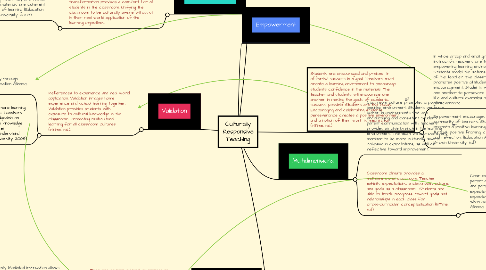
1. Transformative
1.1. Classrooms are changing to fit the learners. In order to be an effective teacher, transformation is key. Becoming culturally aware and implementing the knowledge in your instructional delivery is essential. Cultural awareness and classroom transformation provides a comfort for all students in the classroom. Unifying the classroom to be culturally aware will assist in their real world application of the learning objectives.
1.1.1. Active teaching methods promotes 100% learning in the classroom. Teachers provide instruction to relate to everyone in the classroom. Students are able to verbalize learning when they are familiar. Verbalization of materials are coherent toward mastery of learning (Education Alliance, Brown University. 2008)..
1.1.1.1. In my Classroom, I learned to implement students's interest in the instruction. Students learn and retain knowledge more, when they are able to relate. I adminster a "Get to know you", activitity on the first day of school. I use the data provide to drive instruction with points for the students to reference and be able to speak upon.
2. Validation
2.1. References to experience and real world application. Validation bridges home experience and school learning together. Validation provides students with exposure to cultural knowledge in the classroom. Promoting multicultural learning for all classroom cultures (InTime. n.d.).
2.1.1. Communicating effectively through cultural differences. (Education Alliance, Brown University. n.d.).
2.1.2. Cultural Sensitivity promotes more learning opportunities for the students. Teachers prepare by becoming knowledgeable on cultures in the classroom. The knowledge provides more clarity to present information for students to understand (Education Alliance, Brown University. 2008).
2.1.2.1. My school is filled with different cultures. My goal as a teacher, is to promote cultural awareness to the students. I provide familiar topics with learning concepts, and new example for the students to research and become aware. I complete my research prior to the lesson, to answer and facilitate the discussions.
3. Comprehensive
3.1. Teachers develop cultural awareness to demonstrate to the students. Students are engaged when material is relevant to them. Teachers investing time in cultural knowledge promotes students interest, engagement, and understanding (InTime. n.d.).
3.1.1. Culturally Mediated Instruction allows students to share their cultural knowledge. Students will be able to collaborate and learn from one another's culture. Students can verbalize relations between their cultures toward learning objective . (Education Alliance, Brown University. n.d.).
3.1.1.1. Students will learn about the various cultures in the classroom. The exposure provides awareness to the different cultures in the classroom. Students will compare and contrast the cultures. Awareness provides a fluid learning environment for every student in the classroom
4. Students are encouraged and praised in efforts/ success in a goal. Teachers must create a learning environment to encourage students confidence in the materials. The teacher and students will encourage one another in making the goals of academic success possible. Students are the focus. Encouraging and celebrating students perseverance creates a positive environment, and a notion of their work is meaningful (InTime. n.d.)
4.1. In whole group and small group instruction, teachers are to promote and empowering learning environment. Students model the actions and attitudes of the teacher. The classroom culture promotes positive attitudes and encouragement. Students will encourage one another to persevere through real life and cultural examples of perseverance.
4.2. Empowerment encourages a classroom community of learners. Students will promote a positive learning environment through positive framing, collaboration, and reflection. (Education Alliance, Brown University. n.d.).
5. Empowerment
6. Multidimensional
6.1. Classroom culture promotes a positive learning environment. Students perform better in environments that are encouraging and consistent. Student/ parent communication with teachers provides an olive branch in the learning environment.. The team will improve every member to be more culturally aware, cohesive in expectations, as well as reflective toward improvement.
6.2. Classroom climate provides a multidimensional classroom. Teacher exhibits expectations, a classroom, culture, and goals as a classroom. Students are able to track progress toward goals and relationships in each class for cross-curricular conceptualization (InTime. n.d.).
6.2.1. Clear expectations are communicated to parent and students. In result, students and parents are aware of the expectation, can track progress toward expectations, and receive celebrations when expectations are made (Education Alliance, Brown University. n.d.).
6.2.1.1. My classroom is promoted with positive attitudes and encouragement. I encourage a team oriented learning environment. The team consist of the teacher, students, and parent. My class expectations are provided to the students/parents. I communicate with the team members weekly in implement consistency toward our goal.. I have received growth from students because of the encouragement, consistency, and parental involvement in their studies.

